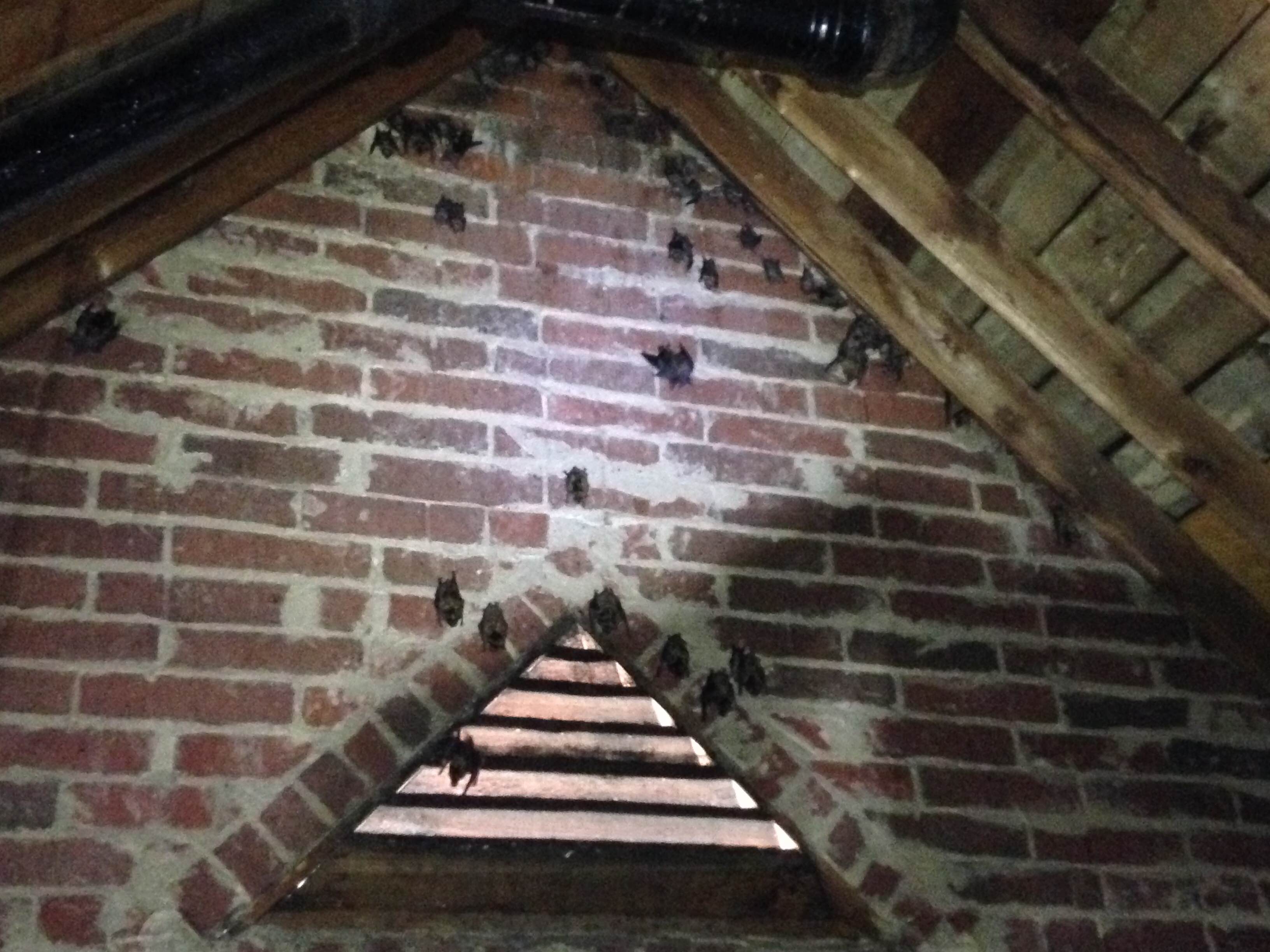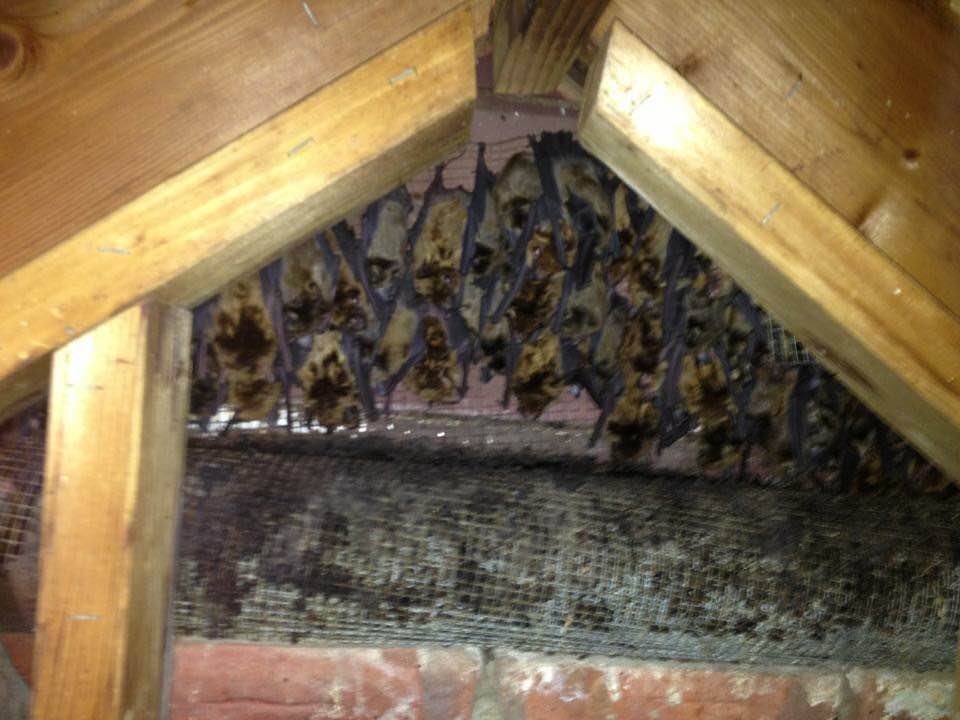How To Exclude Bats Safely From a Attic
 Bat removal from a attic, can be challenging for even the most experienced professional in Louisville, Kentucky. Bats are capable of entering in very small openings as small as 3/8″, and most homes will have many openings left from construction gaps 3/8″ and larger. Bats are also known for their homing abilities, relying greatly on scent markings, roosting locations, and guano accumulations to be attracted continually to a area. Improper exclusion of bats can split the colony to different parts of the home, cause costly damage if the start roosting on the outside, and create a health and safety problem if bats are sealed in and come into the interior of the home. Professional help is recommended for safely removing bats from a attic. This informational page is created to help assist homeowners with the the different aspects needed for successful, safe, and humane bat removal. Animal Pros certified technicians are Bat Standard Compliant and have helped thousands of clients with successful and safe bat removal, offer aesthetic repairs to prevent re-entry and dropping removal and remediation. Contact a Animal Pros specialist today for a evaluation.
Bat removal from a attic, can be challenging for even the most experienced professional in Louisville, Kentucky. Bats are capable of entering in very small openings as small as 3/8″, and most homes will have many openings left from construction gaps 3/8″ and larger. Bats are also known for their homing abilities, relying greatly on scent markings, roosting locations, and guano accumulations to be attracted continually to a area. Improper exclusion of bats can split the colony to different parts of the home, cause costly damage if the start roosting on the outside, and create a health and safety problem if bats are sealed in and come into the interior of the home. Professional help is recommended for safely removing bats from a attic. This informational page is created to help assist homeowners with the the different aspects needed for successful, safe, and humane bat removal. Animal Pros certified technicians are Bat Standard Compliant and have helped thousands of clients with successful and safe bat removal, offer aesthetic repairs to prevent re-entry and dropping removal and remediation. Contact a Animal Pros specialist today for a evaluation.It is important to understand, bats should not be killed or harmed, but only excluded safely.
Bats are beneficial to have around, and capable of eating up to 500 mosquitos nightly.
Some bats are endangered, and you must know local, state, and federal laws before attempting removal.
Bats should not be disturbed during maternity season April – August, unless doing property damage or a immediate threat of health and safety exists.
Bats are capable of being rabid, and will bite.
Bats in the interior of a home, should be submitted to your local health department for testing.
Bat Guano or droppings should be avoided, as they can harbor pathogens, diseases, bacteria, and viruses.
Bats and bat droppings can be responsible for over 60 human communicable diseases.
Instructions on How to Remove Bats In a Attic
 Visual Inspection: A visual inspection is needed to determine how the bats are getting in and out of the structure. They will usually fly out at dusk or right at dark. Sounds of high pitched chirping or squeaking can be heard giving away their roosting areas before they drop out. Once in a attic, bats will often not be found in the open, but will be tucked away in a confined area of the soffit, wall, or a vent. Often, guano or bat droppings will be present under the roosting area. You will need to pay special attention to species of bat, as some are state and federally protected, and to the time of year, as some areas forbid disturbing bats during maternity season.
Visual Inspection: A visual inspection is needed to determine how the bats are getting in and out of the structure. They will usually fly out at dusk or right at dark. Sounds of high pitched chirping or squeaking can be heard giving away their roosting areas before they drop out. Once in a attic, bats will often not be found in the open, but will be tucked away in a confined area of the soffit, wall, or a vent. Often, guano or bat droppings will be present under the roosting area. You will need to pay special attention to species of bat, as some are state and federally protected, and to the time of year, as some areas forbid disturbing bats during maternity season.Pre-Sealing The Outside Of The Home: For proper exclusion to be successful, before bats are excluded, all secondary entry points must be sealed. This would include all openings that are 3/8″ and larger around the top half of the home. You’ll want to leave the primary opening the bats are using alone. All secondary openings must be correctly closed to prevent excluded bats finding a way to gain re-entry. This is often easier said than done, unless you have a “wildlife eye”.
Installing Bat Excluders: Install the excluders over the primary opening of the home. Excluders can be cones, netting, funnels, or other material, that safely allow the bats to fly out, but will not allow them to fly back in. Determining the excluder to use will greatly vary on the location of the primary opening. Normal architecture will only allow some excluders to be conducive, where other devices it may not. This is often the biggest challenge with a bat job, as a improperly hung excluder can allow bats re-entry. Bats will not come out of a primary opening every night, so it is important to understand that bat excluders to remain in place a minimum of 4 – 5 days, or until all the bats are out.
Sealing The Primary Opening: Once you are 100% positive all the bats are out of the attic, you can take down the bat excluder. Now, it is time to seal the primary opening. This is the most important opening to seal, and will require experts skills to ensure there is no gaps left. Because bats are excluded, they will try to gain re-entry, so you must ensure everything is tight and secure. Bats have excellent homing abilities and will return to that opening over time. Bats do not chew to gain re-entry, but will land on the structure, crawl around, and search for a small gap to enter. So it is very important to ensure there is no openings left unsecured, or they will get back in.
Guano Removal and Disinfecting: Bats, even though very small in size, have one of the quickest accumulating droppings of any mammal. Because a single bat can consume up to 500 mosquitos in a night, they can match that with droppings. If you have had a large colony of bats, the droppings can accumulate. Disinfecting and sanitizing services for bat jobs are needed when there is odor from the guano accumulation, there is urine staining, to remove attractants as bats have excellent homing abilities, and to thoroughly clean and disinfect the attic. That can include insulation removal and replacement and other restoration services performed by Animal Pros. This is a important step, as bats will continually be attracted to a roosting area that sells like bats. Contact a Animal Prosspecialist for a evaluation today.
Following these instuctions step-by-step will ensure bats are removed safely and humanely, and will protect your home from a future intrusion. It will not be a simple process, so professional help will be recommended.
Frequently Asked Questions?
Q: Is there any kind of bat repellant that can be purchased to remove bats from my attic?
A: No, there is no repellant for bats. Both ultrasonic sound repellants, and powder and liquid repellants will not be effective for removing bats.
Q: Is there a poison I can put in the attic to kill the bats?
A: No, there is no registered poison to kill bats, and that would be illegal. Exclusion is the only approved method.
Q: What is the cost for bat removal?
A: Since bats are excluded, it will depend upon how many different locations the bats are roosting and how many excluders will need to be installed. Normally, bat removal is very inexpensive.
Q: I would just like bats removed, but do not want openings repaired to prevent them from coming back, can you help?
A: We love to help solve bat problems, but if bats are removed without the openings being repaired, they will just get back in, leaving you with a problem. Bat problems, to be effective and successful, really need to be all the way, or you will be left with a problem.
Why are Bats Attracted To a Attic?
Bats will commonly be attracted to man-made architectural buildings and homes, as they create a perfect roosting area, rather than a tree, outside. Structures offer protection from predators and the elements, much like a cave, while providing a suitable spot during the day to roost. Bats will also utilize structures as a nursery during maternity season mid April – August. The most common bats to utilize structures include the Big Brown Bat, Little Brown Bat, and the Mexican Free-tail Bat. Bats are capable of surviving in a structure, as a attic provides a stable high temperature year round. Soffit voids, roofline gaps, and open vents provide excellent crevices that bats can enter. For help in securing your structure, give Animal Pros a call today.
